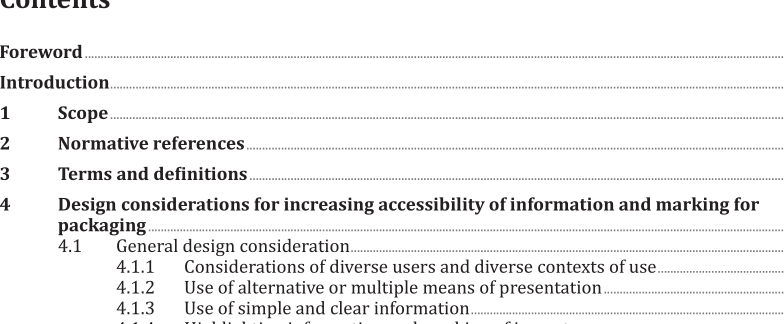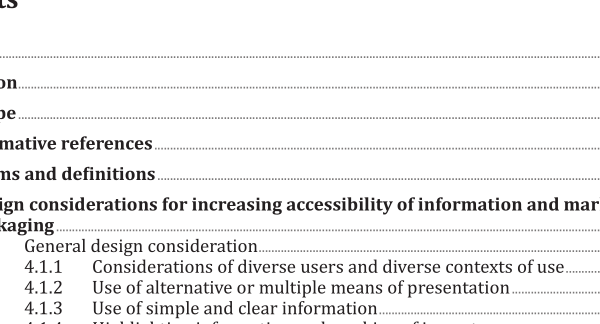ISO 19809:2017 pdf download – Packaging — Accessible design — Information and marking.
3.2 consumer packaging packaging, constituting, with its contents, a sales unit to the final user or consumer at the point of retail [SOURCE: ISO 17480:2015, 3.1] 3.3 context of use combination of specified users, goals and tasks, resources and environment Note 1 to entry: The environment in a context of use includes the technical, physical, social and organizational environments. [SOURCE: ISO 9241‑11:1998, 3.5 — modified.] 3.4 instrument-based evaluation evaluation that uses measurement instruments to obtain data 3.5 user-based evaluation evaluation that uses a method involving users with or without the use of measurement instruments and provides insight into the user’s sensory, physical and cognitive aspects 3.6 tactile information human sensory information generated by touch Note 1 to entry: There are two types of touch sensing. One is passive and the other active, the latter being called haptic. In this document, tactile information means both types of touch sensing. 4 Design considerations for increasing accessibility of information and marking for packaging 4.1 General design consideration 4.1.1 Considerations of diverse users and diverse contexts of use Designing information and marking of packaging shall consider on diverse users and diverse context of use. Diverse users include users with different ages, genders, human abilities (sensory, physical and cognitive), languages, as well as life styles and cultures. Context of use includes different physical environments (lighting, thermal condition), tasks involved in and social and organizational environments. Annex A presents disabilities of human sensory, physical and cognitive abilities, and their consequences, as well as aging effects. 4.1.2 Use of alternative or multiple means of presentation Information and marking on packaging should be presented with at least two different means of presentation for users who are unable to obtain some information due to their disabilities. Whenever possible, multiple means of presentation should be employed to increase accessibility. Different means include different sensory inputs/outputs, different modes of presentation within the same sensory ability, e.g. colours and symbols, and different methods of presentation, e.g. printed letters and audio information.
4.1.3 Use of simple and clear information Information and marking on packaging shall be simple and comprehensive for older people and people with visual and cognitive disabilities to understand the meaning correctly and instinctively. Ambiguous information and marking that cause misunderstanding and misidentification shall not be used. The following considerations may apply but are not restricted to the following: — use consistent expressions with common words, phrases, symbols and pictograms; — select as little information as possible depending on the level of priority of the information; — use a classification or hierarchy of the information when presenting; — use graphic symbols or pictograms rather than long and complex wordings. 4.1.4 Highlighting information and marking of importance Information and marking which are important for correct identification and use shall be clearly shown by highlighting them with different features from the adjacent areas.
ISO 19809:2017 pdf download – Packaging — Accessible design — Information and marking






